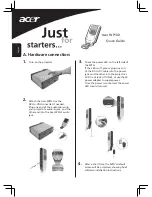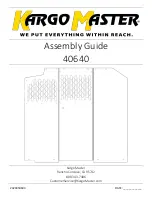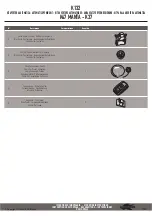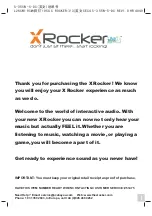
www.balluff.com
15
5.8.
Emergency message
When the device detects an internal error, an emergency object (80
h
+Node ID) with 8-bytes message is
transmitted. The error code is inserted at the location of object 1003
h
(pre-defined error field), and the device
enters the error state which is defined in Object 1029
h
Error Behaviour (default: NMT pre-operational state).
The first 3 bytes indicates the error code specified in CiA301 and error register specified in Object 1001
h
. The
remaining 5 bytes indicate the manufacturer-specific error specified in Object 1002
h
.
Byte8
Byte7
Byte6
Byte5
Byte4
Byte3
Byte2
Bye1
Manufacturer-specific error (1002
h
)
Error register (1001
h
)
EMCY error code (CiA301)
00 00 00 00 00
h
=
no error
00 00 00 00 01
h
=
X
-axis
Cross
-Tilt
Error
00 00 00 00 02
h
=
Y axis Cross
-Tilt
Error
00 00 00 00 08
h
= EEPROM error
More:
Object 1002
h
Manufacturer status
register
00
h
=
no error
01
h
= Generic error
05
h
= Voltage error
81
h
= Manufacturer specific
error
More:
Object 1001
h
Error register
00 00
h
=
No error. Always sent at start-
up
10 xx
h
= Generic error
50 00
h
= Voltage error
50 30
h
= Error during sensor
initialization
60 00
h
= Watchdog error
62 00
h
= Device software error
80 00
h
= Sent at every change of the
manufacturer status register
81 xx
h
= CANopen stack message
82 xx
h
= CANopen stack message
FF 20
h
= EEPROM error
Table 7
– format EMCY message
When all errors are corrected, the device enters the error-free state and transmits an emergency object with the
error code ‘reset error / no error’ containing all 0 s.
5.9.
LSS (Layer Setting Servi ce, according to CiA305 -DSP)
Layer setting services (LSS) and protocols are used to request or change the settings of three parameters of the
physical layer, data link layer and application layer on a CANopen device via the CAN network. It is supported
only in NMT stop mode or pre-operational mode.
The device is serviced as a CAN device, and a CAN master such as a PLC can detect and configure those three
parameters with LSS:
•
Node ID (
→object 3000
h
)
•
CAN bus bit rate (
→object 3001
h
)
•
LSS address: 128-bit number to identify each node uniquely, consisting of the vendor ID, product
code, revision number and serial number with 32 bits each
(→object 1018
h
)
After changing parameters using LSS, a save action must be performed. Normally your LSS tool can be
configured to perform an automatic save (store).
Examples:
00 00 00 00 01 05 50 00
h
—
Voltage error detected during initialization
00 00 00 00 01 81 80 00
h
—
Cross-tilt error on X axis
















































